 The San Francisco Giants have the most engaged fan base in Major League Baseball.
The San Francisco Giants have the most engaged fan base in Major League Baseball.
They're recognized as social media standouts in the sports world.
But as recently as three years ago, they had no cohesive voice on social media and no social media strategy.
The Giants were a traditional organization in a traditional sport. In 2010, when they brought in Bryan Srabian as social media director, they were getting information to fans by broadcasting. Typically this meant holding press conferences and sending out press releases or email blasts.
But then Srabian had an “Aha!” moment. He was reading a book by Chris Brogan and then had a conversation with him on Twitter. “We don't really talk to our fans at all,” he thought. But they could.
It was time for a new model based on listening and responding. But first they had to find out what fans were saying, and where they were getting their information.
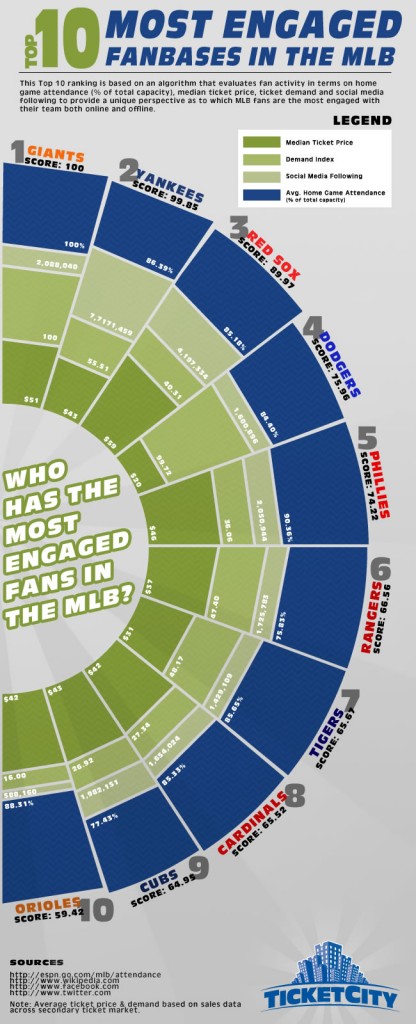
Organization: San Francisco Giants
Social Media Handles & Stats:
- Website
- Facebook – 1,710,480 fans
- Twitter – 451,281 followers
- Instagram – 287,615 followers
- Google+ – 1,104,902 followers
- Pinterest – 8,051 followers
- Tumblr
Highlights:
- Ranked Most Engaged Fans in Major League Baseball by TicketCity, as reported in Forbes magazine
- Routinely sell out 40,000 tickets for home games
- Opened the AT&T Park @Cafe, the first social media headquarters at a major league ballpark, in June 2013
- Social Media Night included a “rain globe” giveaway generated from a fan's idea on social media
Sports teams have a social media advantage in that their customers are already fans. But that advantage is wasted if teams don't harness the power of their existing community.
The Giants have become fan engagement experts by using hashtags strategically, working with existing fan sources, and listening and responding.
Use Hashtags Strategically
When Srabian started as social media director, there was no cohesive voice for the brand. Multiple Facebook pages had been started by different departments. Hashtags were being used on Twitter, but they weren't consistent.
To confuse matters, the New York Giants football team had the Twitter handle @Giants, and were using the hashtag #Giants.
Get World-Class Marketing Training — All Year Long!
Are you facing doubt, uncertainty, or overwhelm? The Social Media Marketing Society can help.
Each month, you’ll receive training from trusted marketing experts, covering everything from AI to organic social marketing. When you join, you’ll also get immediate access to:
- A library of 100+ marketing trainings
- A community of like-minded marketers
- Monthly online community meetups
- Relevant news and trends updates
Hashtags are important in sports because every game is an event. Most of the conversation is about the event, not directed at the team or brand.
“Unless you come regularly, you know very few people at the game, but you're still a part of a community. Using a hashtag is a way to bring those people together,” said Srabian.
The San Francisco Giants consolidated their Facebook pages, settled on the @SFGiants Twitter handle and the unifying hashtag #SFGiants.
A unifying hashtag also allows the team to get a better picture of the conversation. And since Facebook is now using hashtags, they will be even more important.
Srabian worked throughout the 2010-2011 season to get fans and the media consistently using the #SFGiants hashtag. “I basically would use that hashtag in every tweet,” Srabian said.

They promoted the hashtag offline on their printed pocket schedule and on the scoreboard. By the end of the season, most fans and the media were using it.
Sometimes hashtags spring up organically from fans, in which case Srabian's attitude is to be flexible and go with the flow.
That's what happened last October during the playoffs when the Giants were down three games to one. Pitcher Barry Zito was on the schedule for the next game. A fan started the hashtag #RallyZito which took off until it was trending worldwide.

Discover Proven Marketing Strategies and Tips
Want to go even deeper with your marketing? Check out the Social Media Marketing Podcast! Publishing weekly since 2012, the Social Media Marketing Podcast helps you navigate the constantly changing marketing jungle, with expert interviews from marketing pros.
But don’t let the name fool you. This show is about a lot more than just social media marketing. With over 600 episodes and millions of downloads each year, this show has been a trusted source for marketers for well over a decade.
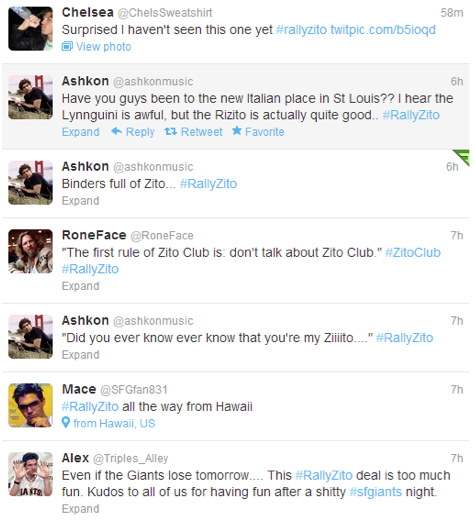
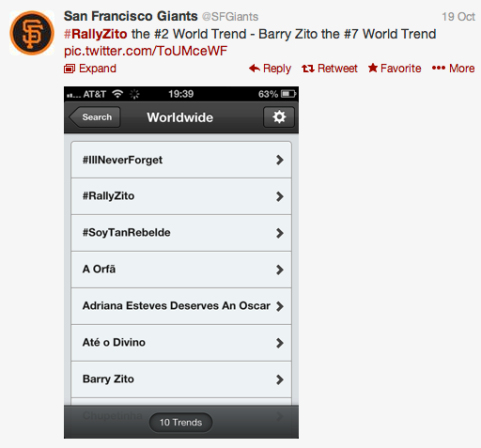
Srabian quickly noticed the trend and used the @SFGiants account to promote it, even changing the official avatar for the occasion.
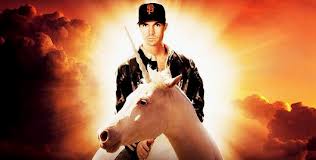
Work With Existing Fan Sources
When Srabian started, he did what he called “auditing the ecosystem” to find out where fans were getting their information. He found some influential bloggers, as well as a fan-run Twitter account that many fans thought was the official account.
Instead of sending cease and desist orders, Srabian reached out to them.
He realized that fans were turning to other sources because they weren't getting what they wanted from the official team social media. “We have more content and more information than any of them, but if we're not sharing it, we're not doing a good job,” he said.
The fan-generated Twitter account was run by a season ticket holder. Srabian approached him and suggested they work together. They gave him access to the stadium and let the relationship evolve as the @SFGiants account ramped up.

Srabian did the same with some influential bloggers, giving them media credentials.
“Our strategy was to have a relationship with them just like traditional media outlets,” he said. “Instead of shutting them down, here's an interesting way to work with someone who was just basically a fan and wanted to work with us.”
One advantage of working with fan accounts is that they can talk about things the official channel can't, such as trade rumors and speculations.
Srabian's ecosystem audit did also uncover a few fake player accounts, which the team shut down.
Listen and Respond to Fans
After establishing the #SFGiants hashtag and determining where fans were getting information, the Giants focused on listening and responding to fans.
“We're not going to respond to every tweet,” said Srabian, “but we get so much information and intel that every so often we get a lightbulb, something that helps us.”
When the promotion schedule is announced, for example, sometimes a particular promo will spark a conversation.
“You could almost predict which games were going to do well and which ones might need a little help,” from the chatter around promos, said Srabian.

Sometimes an idea takes hold with fans and comes to fruition in unexpected ways. During a pennant game, there was a moment when second baseman Marco Scutaro stood with arms outstretched in the rain. In the off-season a fan commented on the McCovey Chronicles blog that it would be cool to make a rain globe of that moment.
Grant Brisbee of McCovey Chronicles wrote a post, “A simple request of the Giants' marketing department,” proposing the team make the rain globe a reality.
“We had so many fans asking, ‘Did you see this?'” said Srabian, “that we decided to actually go ahead and make it.”
The rain globe was a giveaway at the recent Social Media Night. “We think we have good ideas, but our fans have great ideas,” Srabian said.
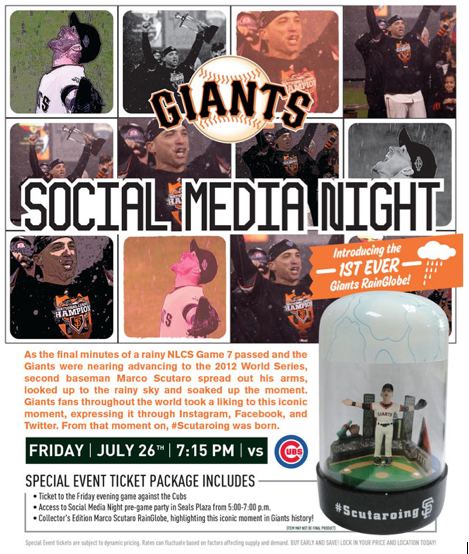
An MLB.com video shows the idea's evolution from a fan's blog comment to the Social Media Night giveaway.
Another way the Giants are engaging fans is with their new @Cafe. It's a social media cafe at center field with flat screens showing fan tweets and Instagram photos.
But ultimately, “You've got to listen more than you react,” on social media, said Srabian. “You can spend all the money you want on software, but just listening to what people say is critical.”
Your Turn
What do you think? How has your favorite sports team used social media? How can you apply the techniques of the San Francisco Giants to your business or event? Include your comments and questions below.
Attention Agency Owners, Brand Marketers, and Consultants

Introducing the Marketing Agency Show–our newest podcast designed to explore the struggles of agency marketers.
Join show host and agency owner, Brooke Sellas, as she interviews agency marketers and digs deep into their biggest challenges. Explore topics like navigating rough economic times, leveraging AI, service diversification, client acquisition, and much more.
Just pull up your favorite podcast app, search for Marketing Agency Show and start listening. Or click the button below for more information.

